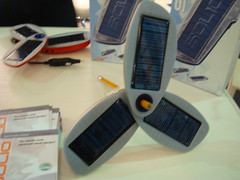
This is a small multifunction recorder/player that fits in the palm of a small child's hand! It comes with 1 GB, 2GB, 4GB, 8GB and 32GB Flash memory. Initially, the 2 GB version was priced at around 60 Euros, but as the new 8 and 32GB versions have come out, so the 2GB version has been dumped into special offer already for around 20 Euros. This would make an idea second or emergency voice recorder for use in the field, especially for recording long events like press conferences. You can also imagine it being used in more clandestine settings for investigative reporting. The audio quality of music playback is superb as well. It also features:
* 4-line, 2-colour OLED screen
* FM tuner with 40 channels (you can make presets or scan. There is frequency readout so you are not tuning in the blind.
* Voice recording with built-in microphone - excellent fidelity, better than you'd expect.
* 92dB signal-to-noise ratio
* Formats: MP3, WMA (including protected), Audible
* Battery life of the internal rechargeable battery: 15 hours
* Dimensions: 2.2" x 1.4" x 0.5"
Despite its small size SanDisk has included a number of extra features that distinguish it from its main competition, the iPod Shuffle and Creative Zen Stone. Most notably is the inclusion of the 4-line OLED screen that lets you browse through your audio collection and toggle settings from the player itself.
Alongside the radio functionality is the ability to record FM broadcasts off the internal FM radio, and record interviews through the integrated microphone. All recordings are saved in the WAV file format.On the format side the standard formats are supported, but no support in some of the older versions for some of the less popular audio formats such as Ogg Vorbis. The Sansa Clip was released on October 9, 2007. The player has a similar design to the second-generation iPod shuffle, but the clip is removable and a 4-line OLED screen is built-in (one line orange-ish yellow, three blue.) The Clip has an FM tuner/recorder (optional in Europe) and a built-in microphone. The flash-based player ships in capacities of 1 GB (available only in black), 2 GB (available in black, blue, red and pink), and 4 GB, 8 and 32 GB (available in reflective silver).
Firmware version 01.01.29, released in May 2008, enables Ogg Vorbis compatibility for the Sansa Clip. However, OGG comment (the counterpoint of MP3's ID3-tags) support is still buggy.
Support for Audible audio books, and protected WMA support are both notable features of the Clip. It also integrates with Rhapsody's subscription service available in the USA and lets you mark songs so they are automatically purchased next time you sync the player with your computer.
One con: The internal battery can only be charged through a USB port, or from a separate USB charger. No quick battery changes here, so keep it charged.
The new firmware is
free and has various bug fixes, including key fixes listed below, as well as enhancements. Upon completion of the firmware upgrade, the device will turn off. Power on the device to complete the upgrade process. If the device does not initiate or complete, press & hold the Power switch for 6 seconds to reset the device and then release and press again to restart.
Bugs Fixed:
Rhapsody Licenses
· Rhapsody licenses expire early.
Battery Indicator
· Battery indicator is not linear with respect to the play time remaining.
Fast Forward / Rewind Long MP3
· Device will skip to next song if fast forward past halfway through a long vbr mp3 file.
Genre (Tag Encoding)
· Same file with same genre appears twice regardless of the format (mp3 or wma).
FM Autoscan
· Device does not return to FM tuner display after scanning for stations.
Custom EQ Settings· Custom EQ settings get cleared after power cycle.
Miscellaneous Deleting files on the device is not stable.
Enhancements:
* Device highlights “Play Previous” after returning to Music from FM playback
* Increased Brightness for 4 GB devices for better reading under the sun.
* Added OGG-Vorbis (*.ogg) Decoder Support in MTP and MSC mode:
• Note: PC with WMP10 will not be able to drag and drop OGG files to device under MTP mode
• Workaround: Install WMP11 to PC or use MSC mode instead.
* Audiobooks and Podcasts sorting and resume features:
• Content placed in Audiobook or Podcast Folders are now accessed separately from Music.
• Content with Genre tags of "Audiobook" or "Podcast" are now handled from any location and sorted by the UI.
• PodCasts and Audiobooks are now organized by 2 level hierarchies.
• Podcast content is sorted with newest episode first.
• Auto Bookmark: will prompt the user with "Resume?" or "Restart" option when restarted.
* Much better shuffle algorithm to maintain the sequence of up to 2000 songs. User can skip to the previously played songs without reshuffling. Sequence is preserved after power off and on.
* Handle playlists up to 1000 songs. Fixed playlists with large count taking long time to load.
• Note: Playlist limited to 1000 songs only applied to .pla playlist. For .m3u playlist, there is no limitation.
* Battery power percentage is now displayed on the “Settings > System Info” screen.
* Device auto powers off if the radio is paused / muted.
* Add support for Melon SKT (South Korea Telecom) MusicDRM v1.4 (For Korea market).
* Performs faster, more complete MTP Format operation.




















